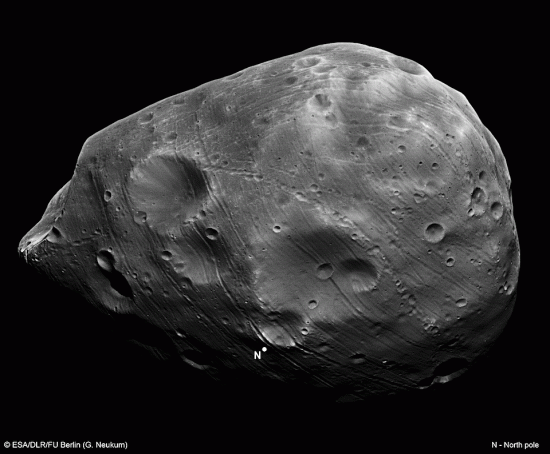Jan 21, 2013
Did meteor bombardment scar Phobos?
Phobos is the largest of the two moons of Mars. Deimos is so small that studying its surface has been problematic for astronomers because it cannot be readily observed from Earth. Only the Viking 2 orbiter, and more recently, the HiRise camera onboard the Mars Reconnaissance Orbiter captured close up images. Phobos, on the other hand, has been examined by Earth stations and by satellites sent to Mars orbit.
In the image above, Stickney crater is visible on the left. Stickney is a ten kilometer-wide excavation that is nearly the size of Phobos itself. In previous Thunderbolts Picture of the Day articles, rocky bodies with craters almost as large as themselves have been discussed. As was pointed out, the “impact” craters should have blasted the objects into fragments, but little sign of the collisions is visible other than the craters. In the case of Phobos, the moon is 28 by 20 kilometers in size, so Stickney crater is nearly half as large as the moon.
Some astronomers have reported that the striations and fracture lines evident around Stickney demonstrate that the moon did undergo severe shock, and that it was distorted by the impact of whatever formed the crater. However, on closer examination it was revealed that the striations are, in reality, chains of small craters. No “fracture lines” are visible – no cracks as if from a titanic shock wave passing through the moon’s body. In fact, the area surrounding the crater is rounded and smooth with no large blast debris (although the moon is covered with almost a meter of finely divided dust).
Because Phobos is in the same size range as some asteroids such as Mathilde, Eros and Ida, and it exhibits features like the relatively gigantic craters that are endemic to those bodies, what is the common event that creates such similar structures without obliterating the objects in the first place? The answer is electricity.
In past reviews of Mars, for example, it appears that the Red Planet was immersed in a plasma flame sufficiently large to gouge out Valles Marineris, Olympus Mons and Arabia Terra in a relatively short period. Gigatons of rock and dust were literally ejected from the planet and thrown into space at escape velocity. Blocks of stone as large as Manhattan Island look like they fell from a great height and shattered on impact, leaving fields of enormous boulders with sharp, angular edges covering hundreds of square miles. Could it be that Phobos, Deimos, Ida and the rest are also the remnants of that overwhelming cataclysm?
In a possible scenario, the thunderbolts that carved up Mars threw big chunks of its crust into orbit, as well as into long ellipses around the Sun. While ramming through the electrical fields involved with the EDM process, they were smoothed and eroded by the arcs. Touchdown points where the discharges were more intense became deeply incised. The result is that Phobos and the asteroids mentioned are covered in dust, have little or no large boulders, are defined by huge craters and look like they’re half-melted.
In conclusion, Phobos and Deimos appear to be the remains of a catastrophic event that electrically devastated their parent planet, leaving them as wandering orphans forever looking down on what was once their home.
Stephen Smith













